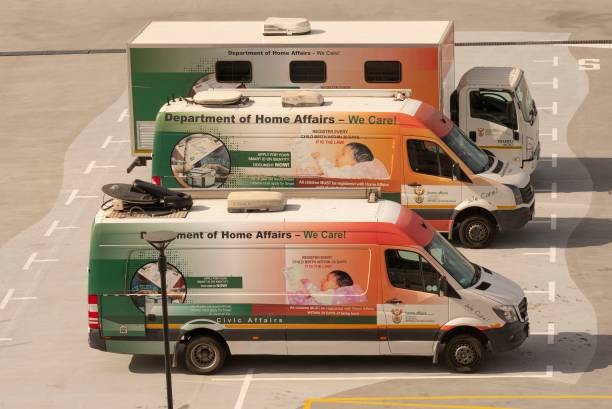Omanyano ovanhu koikundaneki yomalungula kashili paveta, Commisiner Sakaria takunghilile
Veronika Haulenga
Omanyano ovanhu koikundaneki yomalungula kashili paveta, Commisiner Sakaria takunghilile
Veronika Haulenga
Listeners:
Top listeners:
-
play_arrow
Omanyano ovanhu koikundaneki yomalungula kashili paveta, Commisiner Sakaria takunghilile Veronika Haulenga
South Africa needs to manage migrants better. That requires cleaning up the Department of Home Affairs


By Alan Hirsch, University of Cape Town
Legal grievances against the South African Department of Home Affairs, including contempt of court cases, are depressingly common. Too frequently the minister has to apologise to a court, or to ask for more time, on behalf of the department. Most of the court cases involve the operations of the department regarding visas and permits for foreign visitors, immigrants and prospective refugees.
Just a few months ago home affairs minister Aaron Motsoaledi said, in legal papers:
I would like to take this opportunity to extend my sincere apology to the Chief Justice, all judges of the high court and Constitutional Court, the President of South Africa, Minister of Finance, Lawyers for Human Rights and its legal representatives and the people of South Africa for the mess created by officials of the Department of Home Affairs.
This particular mess was triggered by the minister’s failure to amend an unconstitutional law which allowed for the detention of irregular migrants for 120 days.
The rotten state of the department is widely known. Two reports released in the last three years, commissioned by the minister and the presidency and led by senior and seasoned individuals, set out the problems in detail. One, released in 2022, chronicled a backlog of visa, permit and status applications, evidence of fraudulent applications being first rejected, then accepted, and the system being used illegally. The other found multiple failures in the provision of visas to senior business managers and experts.
The issue of migration policy and its implementation has never been more pressing for South Africa. Immigration has grown relatively rapidly in the past 20 years. The proportion of migrants to local people more than doubled from a relatively low level of 2.1% in 2000 to a moderate level of 4.8% in 2020, according to a study drawing on UN data.
The global average immigrant population is around 3.5% but countries like the US (nearly 16% in 2019), Australia and New Zealand are much higher. Côte d’Ivoire is the only country on the continent with a considerably higher percentage of immigrants than South Africa.
Migration policy is likely to be a key issue in South Africa’s forthcoming elections. A leading journalist has argued that 2024 will be an “immigration election”. Populist parties are expected to mobilise around people’s fears, while the government will continue to use immigration as an excuse for poor service delivery and joblessness.
The reality is that the impact of migrants on the circumstances of poor South Africans is marginal, and far less important than the very poor performance of the economy and many governmental institutions.
In a paper just published I examine the recent history of immigration policy in South Africa. I argue that the challenges would best be addressed by improvement in the operations of the Department of Home Affairs. This should be accompanied by some modernisation of migration law to encourage the use of regular migration channels and discourage irregularity.
The problems
The first of the two investigations initiated by the minister was headed by Cassius Lubisi, former secretary of the cabinet. The second was headed by anti-apartheid struggle stalwart Mavuso Msimang.
Their main findings were as follows.
Fraudulent documentation was used in 36,647 applications for visas, permits or status over a 16-year period. Of these, 880 were approved and 288 were pending. 4,160 of the fraudulent applications were first rejected, and then accepted after reconsideration.
Systems that had been replaced were still being used illegally from time to time. The outcomes of such activities were suspicious. In some cases applications were processed in zero days. The investigation found visa expiry dates issued beyond the legal limit.
The department’s databases for naturalisation and population registration didn’t correlate with each other.
The list identifying undesirable immigrants was “fatally flawed due to incomplete and missing crucial data”.
In some cases, files had been inserted illegally into the information system. This process would require “a highly skilled IT user with administrator rights to execute”.
There were multiple cases of “forum-shopping” by applicants. This is when an applicant applies for a range of unrelated permits in the hope that one of them will get through.
The department did not have systems that could identify multiple applications by the same person.
Possible fixes
The Department of Home Affairs recently issued a draft white paper which it said was aimed at addressing the problems that had been identified.
It proposed severely curtailing the rights of prospective refugees, restricting paths to citizenship, and strengthening the Border Management Authority and supportive institutions.
But, based on my findings, it is clear that these changes won’t solve the problems. Experts show that tighter restrictions lead to greater illegality, not less migration.
The most disappointing element of the draft white paper is that it makes no reference to recommendations made in the two reports on the problems at the department.
Recommendations of the reports included:
- major investment in and reorganisation of information systems
- the integration of the various population databases
- further forensic investigations to root out corruption
- hiring and training staff with skills and integrity.
The draft white paper also does not mention the need to modernise the colonial-style bilateral labour agreements which South Africa maintains with five regional neighbours – Mozambique, Lesotho, Eswatini, Malawi and Botswana. These countries, and Zimbabwe, are the greatest source of regular and irregular migration.
These agreements are no longer fit for purpose. Firstly, they impose tight restrictions on the rights of contracted migrants from other countries. Secondly, they are based on patterns of migrant labour developed during the colonial period to support farming and mining. Thirdly, they’re written up on the basis of an unequal relationship between countries of the southern African region.
Modern bilateral labour agreements have been developed. An example is the Canadian system. It provides for long term arrangements with full labour and social rights for the duration of the multiyear contract, but no right to permanent residence for the workers or their families.
Modern Canadian-style migrant labour agreements would encourage more migrants to choose regular migration routes and fewer would try to evade or abuse the law.
The draft white paper gives the impression that the challenge of migration policy can be solved with tighter laws on refugees and citizenship. In fact the fundamental problem is the corruption and inefficiency in the permits and visa section of the department, which the white paper hardly mentions.
The unfortunate conclusion that can be drawn from a reading of the draft white paper is that it was designed primarily to give the ruling party a narrative for the upcoming election, rather than to reform the migration governance regime.![]()
Alan Hirsch, Research Fellow New South Institute, Emeritus Professor at The Nelson Mandela School of Public Governance, University of Cape Town
This article is republished from The Conversation under a Creative Commons license. Read the original article.
Written by: Contributed
Bilateral Labor Agreements corruption Department of Home Affairs Draft White Paper Election Issues Governance Reform Immigration Policy Legal Issues Migration Challenges Operational Efficiency South Africa Visa Processing
Similar posts
Windhoek Weather
Most popular

Mbumba signs off new benefits for retired political office bearers

Former FNB employee arrested after defraud pensioner off N$215, 000

Namdia Heist: More questions, lots of confusion

Omuhwahwameki Michael okuunganeka oshikonga shoku patitha oostola dho Rani moshilongo ashihe.

Walvis Bay woman loses over N$777.000 to a fraudster
Copyright 2025 Future Media (Pty) Ltd | Website by Digital Platforms
Tel: +264 83 000 1000 | Email: news@futuremedia.com.na





